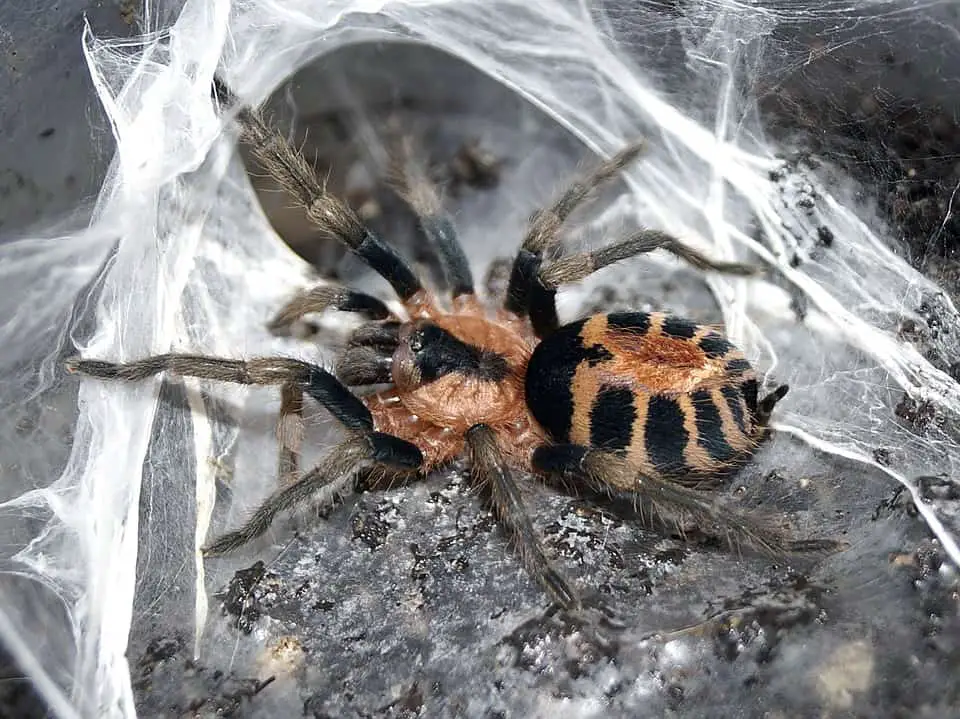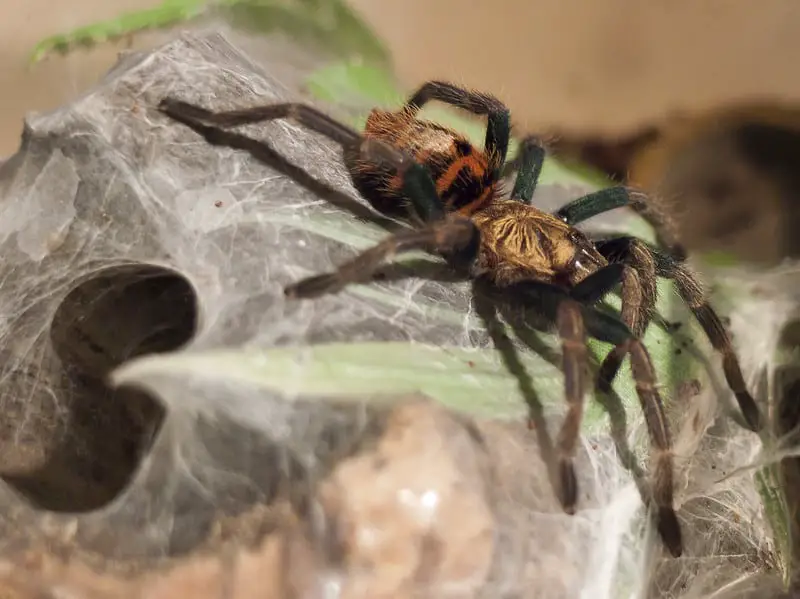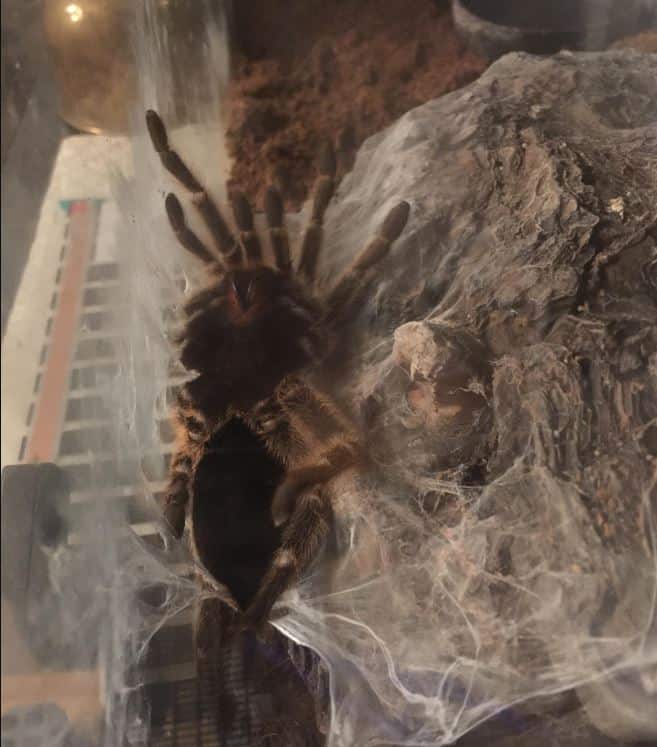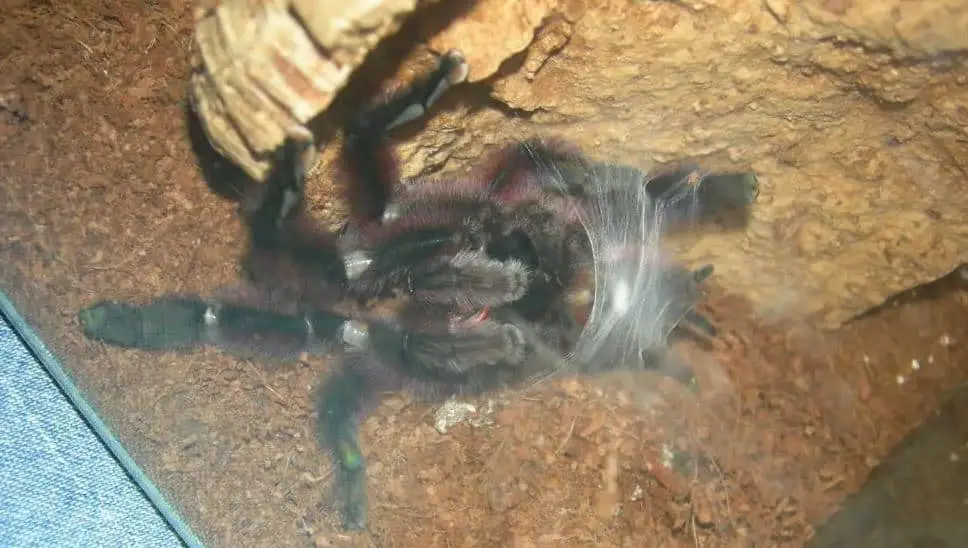Tarantulas. For some people they’re creepy, crawling, eight-legged monsters, for others, they’re beloved pets. Wherever you fall on the spectrum, it’s undeniable that they’re interesting creatures. There are over 800 identified species, all with unique characteristics, colors, patterns, and sizes. Despite there being so many of them, people often have questions about them. One question that comes up often is if tarantulas make webs.
Tarantulas are indeed capable of spinning webs, and some species can create impressive constructions. However, since they’re such large spiders they do not sit in their web and wait for flies to get stuck in it before devouring them.
Let’s take a closer look at the webbing behavior of these beautiful spiders, shall we?

Do tarantulas make webs?
Tarantulas do indeed make webs, but they do not make the typical spider webs that their relatives do. They are way too big to create webs to sit in. After all, prey would easily notice a 7″ spider sitting in a web! This would make it very difficult for them to catch prey. In addition, they’re way too heavy for their web to support them in the first place!
Nevertheless, despite the fact that they cannot spin their silk between branches in hopes of catching prey, they do indeed create webs. Why is that exactly? Let’s find out.
Why do tarantulas spin webs?

Protection
The first reason why tarantulas spin webs is that it allows them to close the entrance to their burrow. Spinning silk helps to prevent intruders from entering their homes. Tarantulas might look big and fearsome, but they do have predators. Certain snakes and lizards would love nothing more than a juicy tarantula for dinner. To prevent that from happening, they blockade the entrance to their burrows using silk, twigs, and leaves.
Structural integrity
Tarantulas often line the walls of their burrows with silk. They do this instinctively because in the wild the silk makes their home more structurally sound.
Now, you might think that in captivity that’s not really necessary. After all, there’s no chance of a storm occurring in their tiny enclosure. That’s true, but spiders are not very smart. Honestly, they probably don’t even realize that they live in captivity. These animals act mostly on instinct. Their instincts tell them to reinforce their home with silk, so that is what they do.
Relaxation
Did you know that tarantulas can create hammocks with their webs? It’s true! Take a look at this picture I found on Reddit of a Chilean Rose constructing a hammock to chill in:

The owner said that she even molted in this hammock afterward. Imagine how convenient it would be if you were capable of constructing a hammock wherever you go…
Moving around
Lining their enclosure in silk also makes it easier for them to move around. Which in turn makes it easier for them to catch their prey. Furthermore, they can sense the vibrations in the webbing which helps them locate prey. This is important because tarantulas do not have very good eyesight.
Sperm web
One very important reason why male tarantulas create webs is for reproduction. In order for them to be able to reproduce they need to transfer their sperm from the epiandrous fusillae to the palpal bulbs. They do this by loading their reproductive material on the web and then transferring it. When this is done, the spider is ready to mate.
Many owners never see this because the spiders don’t often do this out in the open. Furthermore, they tend to destroy the webs when they’re done. Nevertheless, it’s a crucial thing for them to do. Without it, they would not be able to reproduce!
To get an idea of what it looks like, check out this picture of a Versicolor:

Which tarantula species create webs the most?
However, since there are so many different tarantula species, there are of course differences in the amount of webbing that they do. Some species are more prolific than others. Let’s take a closer look at which species have the biggest tendencies to spin silk.
Generally speaking, arboreal species tend to create webs more often than terrestrial species. If you’d like to add a species that creates a lot of webs to your collection, consider one of the following tarantulas:
- Orange Baboon. If spider webs are your thing, the orange baboon is your spider. These beautiful orange tarantulas have a strong tendency to create intricate constructions that are very interesting to behold. However, be cautious, they’re not for the faint of heart. They have a mean personality and are not recommended for beginners!
- Greenbottle Blue. The Greenbottle blue is known for its stunning appearance. It’s not only very beautiful to look at, but it’s also a prolific webber. This species is great for beginners, so if you’re new to the hobby this is a great tarantula to get your feet wet.
- Indian violet tarantula
- Socotra Island Blue Baboon. An interesting this about this species is that they not only do heavy webbing, but they’re capable of communal living!
- Antilles Pinktoe tarantula
- Brazilian Blue Dwarf Beauty
- Guatemalan tiger rump
However, even though these species have the biggest tendencies to create webs, every spider is unique. Some will never create a web in their life. If you have one of these species and notice that they’re not interested in this practice at all, don’t worry. Some tarantulas simply do not care about creating webs.
Interesting facts
- The Brazilian Jewel Tarantula creates trapdoor webs which it uses to catch prey.
- An interesting distinction between the tarantula and other spiders is that tarantulas create their silk with their feet, whereas other spiders use their spinnerets.
- Males as well as females create webs
Final words
Tarantulas do create webs but for very different reasons than other spiders. The primary reasons why they spin silk are protection, reinforcing their burrows, moving around, and hunting.
However, since there are hundreds of different species, not all tarantulas web in equal amounts. Some do not web at all while others create impressive structures.
- How Long Do American Eskimo Dogs Live? Important Factors and Care Tips - September 29, 2023
- Do American Bulldogs Need Grooming? Essential Tips and Care Guidelines - September 29, 2023
- Do Bengal Cats Enjoy Playing? Essential Tips for Keeping Them Active - September 29, 2023